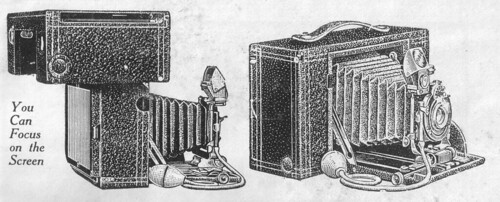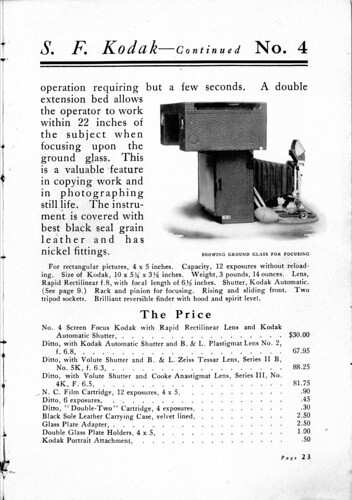Difference between revisions of "No. 4 Screen Focus Kodak"
(scans all CP -> CW; added rights and one attribution caption) |
|||
| Line 1: | Line 1: | ||
| − | |||
| − | |||
| − | |||
| − | |||
| − | |||
| − | |||
{{Flickr_image | {{Flickr_image | ||
| − | |image_source= http://www.flickr.com/photos/ | + | |image_source= http://www.flickr.com/photos/uwe_kulick/1965919163/in/pool-camerawiki |
|image= http://farm3.static.flickr.com/2324/1965919163_64a2abd67b.jpg | |image= http://farm3.static.flickr.com/2324/1965919163_64a2abd67b.jpg | ||
| − | |image_align= | + | |image_align= right |
| − | |image_text= | + | |image_text= |
| + | |image_rights=pd | ||
}} | }} | ||
At the turn from the 19th to the 20th century the inconvenience with the new rollfilm cameras concerning the way of estimated image composition through the viewfinder led to a new type of camera, the combination camera. This type had a rollfilm back that could be swung out of the focal plane to give place for a ground glass. [[Blair]] offered the ''No. 3 Combination Hawk-Eye''. [[Manhattan Optical Co.|Manhattan Optical]] sold its ''Wizard Duplex''. And [[Kodak]] its '''No. 4 Screen Focus Kodak'''. The rollfilm back could be removed completely so that the camera served as 4×5" plate camera. In 1905 the camera was equipped with [[Rapid Rectilinear]] lens and a Kodak Automatic shutter. It had a rising and sliding front and even a viewfinder, a brilliant reversible finder with hood. It used type No. 123 roll film for 4×5" exposures. It was a very expensive camera, The concurrent model of Blair did cost just one third. However, ca. 4000 No. 4 Screen Focus were made. | At the turn from the 19th to the 20th century the inconvenience with the new rollfilm cameras concerning the way of estimated image composition through the viewfinder led to a new type of camera, the combination camera. This type had a rollfilm back that could be swung out of the focal plane to give place for a ground glass. [[Blair]] offered the ''No. 3 Combination Hawk-Eye''. [[Manhattan Optical Co.|Manhattan Optical]] sold its ''Wizard Duplex''. And [[Kodak]] its '''No. 4 Screen Focus Kodak'''. The rollfilm back could be removed completely so that the camera served as 4×5" plate camera. In 1905 the camera was equipped with [[Rapid Rectilinear]] lens and a Kodak Automatic shutter. It had a rising and sliding front and even a viewfinder, a brilliant reversible finder with hood. It used type No. 123 roll film for 4×5" exposures. It was a very expensive camera, The concurrent model of Blair did cost just one third. However, ca. 4000 No. 4 Screen Focus were made. | ||
| − | + | ||
| − | |||
| − | |||
| − | |||
| − | |||
| − | |||
===Links=== | ===Links=== | ||
*[http://www.antiquewoodcameras.com/screenfo.htm No. 4 Screen Focus Kodak] at Antique & 19th Century Cameras [http://www.antiquewoodcameras.com] | *[http://www.antiquewoodcameras.com/screenfo.htm No. 4 Screen Focus Kodak] at Antique & 19th Century Cameras [http://www.antiquewoodcameras.com] | ||
*[http://www.nwmangum.com/Kodak/No4SFK-1.html No. 4 Screen Focus Kodak as plate camera] at Kodak Collector's [http://www.nwmangum.com/Kodak/] | *[http://www.nwmangum.com/Kodak/No4SFK-1.html No. 4 Screen Focus Kodak as plate camera] at Kodak Collector's [http://www.nwmangum.com/Kodak/] | ||
*[http://www.eastman.org/fm/mees/htmlsrc/mE13000510_ful.html Model A] at George Eastman Archives [http://www.eastman.org] | *[http://www.eastman.org/fm/mees/htmlsrc/mE13000510_ful.html Model A] at George Eastman Archives [http://www.eastman.org] | ||
| + | |||
| + | |||
| + | {|class=floatleft | ||
| + | | | ||
| + | {{Flickr image | ||
| + | | image_source=http://www.flickr.com/photos/mario_groleau/5225170388/in/pool-camerawiki | ||
| + | | image=http://farm6.static.flickr.com/5004/5225170388_c28ee6815b.jpg | ||
| + | | image_align=left | ||
| + | | image_text= | ||
| + | }} | ||
| + | | | ||
| + | {{Flickr image | ||
| + | | image_source=http://www.flickr.com/photos/mario_groleau/5225169914/in/pool-camerawiki | ||
| + | | image=http://farm6.static.flickr.com/5083/5225169914_ee963159f0.jpg | ||
| + | | image_align=left | ||
| + | | image_text= | ||
| + | }} | ||
| + | |- | ||
| + | |colspan=2 align=center | <small>scans courtesy {{image author|Mario Groleau}}</small> {{public domain}} | ||
| + | |} | ||
[[Category:Kodak|4 Screen Focus Kodak]] | [[Category:Kodak|4 Screen Focus Kodak]] | ||
[[Category:1900-1905]] | [[Category:1900-1905]] | ||
[[Category:US-American 4x5in folding]] | [[Category:US-American 4x5in folding]] | ||
Revision as of 17:13, 21 October 2011

|
| (Image rights) |
At the turn from the 19th to the 20th century the inconvenience with the new rollfilm cameras concerning the way of estimated image composition through the viewfinder led to a new type of camera, the combination camera. This type had a rollfilm back that could be swung out of the focal plane to give place for a ground glass. Blair offered the No. 3 Combination Hawk-Eye. Manhattan Optical sold its Wizard Duplex. And Kodak its No. 4 Screen Focus Kodak. The rollfilm back could be removed completely so that the camera served as 4×5" plate camera. In 1905 the camera was equipped with Rapid Rectilinear lens and a Kodak Automatic shutter. It had a rising and sliding front and even a viewfinder, a brilliant reversible finder with hood. It used type No. 123 roll film for 4×5" exposures. It was a very expensive camera, The concurrent model of Blair did cost just one third. However, ca. 4000 No. 4 Screen Focus were made.
Links
- No. 4 Screen Focus Kodak at Antique & 19th Century Cameras [1]
- No. 4 Screen Focus Kodak as plate camera at Kodak Collector's [2]
- Model A at George Eastman Archives [3]
|
| ||||
| scans courtesy Mario Groleau (Image rights) | |||||

